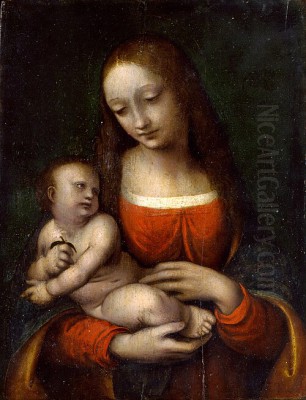
Giovanni Pietro Rizzoli, more famously known by the diminutive "Giampietrino," stands as a significant yet somewhat enigmatic figure in the landscape of Italian Renaissance art. Active primarily in Milan and Lombardy from approximately 1495 to 1549, his career unfolded during a period of extraordinary artistic ferment, largely dominated by the towering presence of Leonardo da Vinci. Giampietrino is celebrated as one of the most gifted and prolific of the "Leonardeschi"—the circle of artists who were pupils, assistants, or profound admirers of Leonardo, and who played a crucial role in disseminating his revolutionary style and techniques. While his personal life remains shrouded in considerable obscurity, his artistic output offers a compelling testament to his skill, his deep engagement with Leonardo's innovations, and his own distinct sensibility that resonated with patrons for decades.
The Enigma of Identity and Name
For many years, the precise identity of the artist known as Giampietrino was a subject of scholarly debate. The name "Giampietrino" itself, a diminutive suggesting familiarity or perhaps a workshop appellation, appears in various historical documents, but linking it definitively to a specific individual proved challenging. Some early art historians proposed identifications with figures like Giovanni Pedrini or a "Gian Pietro" mentioned in Leonardo's own notebooks, specifically the Codex Atlanticus. This latter reference, noting a "Gian Petro," is a crucial piece of evidence suggesting a direct connection to Leonardo's studio environment.
It is now widely accepted by art historians, following extensive research and archival discoveries, particularly by scholars like Sydney J. Freedberg and later Cristina Geddo, that Giampietrino is Giovanni Pietro Rizzoli. This identification has helped to consolidate his oeuvre and provide a more concrete, albeit still incomplete, biographical framework. The confusion surrounding his name underscores the complexities of art historical research, especially for artists who may not have achieved the same level of contemporary fame or documentation as their more celebrated mentors. Despite these historical ambiguities, the body of work attributed to Giampietrino reveals a consistent artistic personality of considerable talent.
Milanese Artistic Milieu and Early Influences
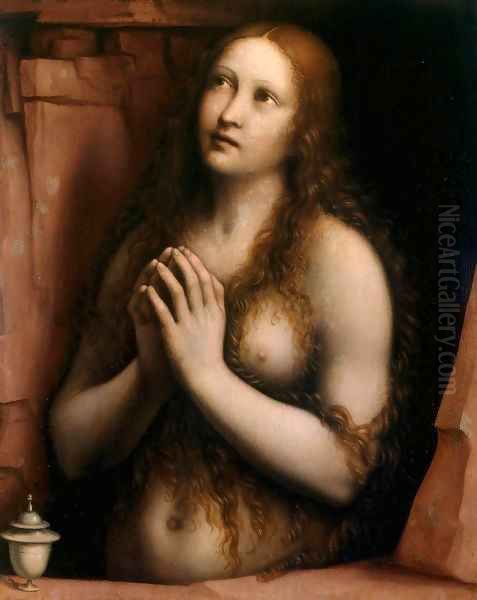
Giampietrino's artistic journey began in Milan, a vibrant cultural hub, especially under the rule of the Sforza dukes, who were notable patrons of the arts. Before Leonardo da Vinci’s transformative arrival in Milan around 1482, the Lombard artistic scene was characterized by the work of painters such as Vincenzo Foppa, Ambrogio Bergognone, and Bernardino Butinone. These artists established a tradition of detailed realism, often imbued with a certain sobriety and a strong devotional quality. This local Lombard style, with its emphasis on meticulous rendering and expressive, if sometimes austere, figures, would have formed the foundational artistic language for a young painter like Giampietrino.
While direct evidence of his earliest training is lacking, it is plausible that Giampietrino received his initial instruction within this existing Lombard tradition. However, the arrival and extended presence of Leonardo da Vinci in Milan, first from c. 1482 to 1499 and later from 1506 to 1513, irrevocably altered the course of art in the region. Leonardo's revolutionary approach to composition, his mastery of sfumato (the subtle, smoky blending of tones), his profound understanding of human anatomy and psychology, and his innovative use of light and shadow (chiaroscuro) captivated and influenced a generation of artists.
In Leonardo's Orbit: The Leonardesque Phenomenon
Giampietrino is considered one of the most prominent members of the Leonardeschi. This group, which included artists such as Giovanni Antonio Boltraffio, Andrea Salai (Gian Giacomo Caprotti), Francesco Melzi, Marco d'Oggiono, Cesare da Sesto, Bernardino Luini, and Andrea Solario, responded to Leonardo's genius in diverse ways. Some, like Melzi, became devoted disciples and custodians of his legacy. Others, like Boltraffio and Luini, developed more independent styles while clearly absorbing Leonardesque principles. Giampietrino carved out his own niche, becoming a highly productive artist who skillfully adapted Leonardo's models and motifs.
The mention of a "Gian Petro" in Leonardo's Codex Atlanticus suggests that Giampietrino was likely part of Leonardo's workshop, at least for a period. This direct exposure would have provided him with unparalleled opportunities to observe Leonardo's working methods, study his drawings and unfinished paintings, and absorb his artistic theories. The impact is evident in Giampietrino's soft modeling of flesh, the enigmatic smiles reminiscent of Leonardo's figures, the sophisticated use of chiaroscuro to create volume and atmosphere, and the often complex, psychologically charged interactions between his subjects. He became particularly adept at replicating the delicate sfumato that was a hallmark of Leonardo's style, lending his figures a gentle, almost ethereal quality.
Artistic Style and Thematic Concerns
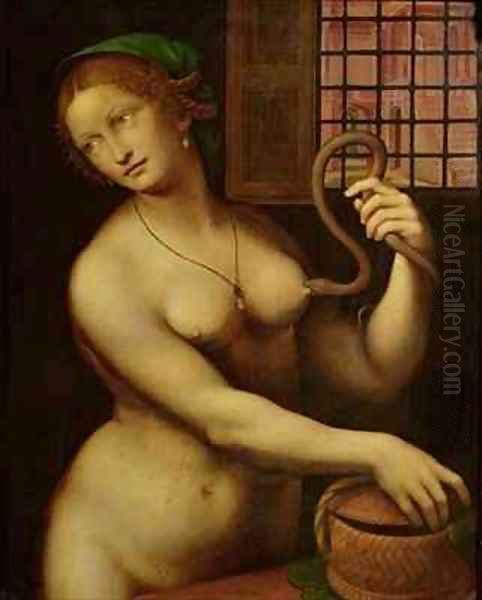
Giampietrino's style is characterized by its refinement, technical polish, and a distinctive, often melancholic, sensibility. His figures typically possess an idealized beauty, with smooth, porcelain-like skin, delicately rendered features, and flowing, intricately arranged hair. He favored a palette that could range from rich, jewel-like tones to more subdued, almost monochromatic schemes, often employing a subtle pinkish hue in the flesh tones that became a recognizable trait. His compositions, while often derived from Leonardesque prototypes, demonstrate a confident handling of form and space.
A significant portion of Giampietrino's oeuvre consists of religious subjects, particularly depictions of the Madonna and Child, female saints, and scenes from the life of Christ. He produced numerous versions of the Madonna and Child, often with the infant St. John the Baptist, exploring subtle variations in pose and emotional expression. These works catered to the strong demand for private devotional images. His depictions of female saints, such as Mary Magdalene, St. Catherine of Alexandria, and Lucretia (though a Roman heroine, often depicted with saintly pathos), are particularly noteworthy. These figures are often portrayed half-length, imbued with a captivating blend of spiritual intensity and subtle sensuality, their languid poses and enigmatic expressions echoing Leonardo's psychological depth.
Mythological and allegorical subjects also feature in his work, including several versions of Leda and the Swan, a theme popularized by Leonardo, and depictions of Cleopatra. In these, Giampietrino often emphasized the graceful eroticism of the female form, rendered with his characteristic smooth finish and delicate modeling. This ability to navigate between the sacred and the profane, often imbuing religious figures with a gentle allure and mythological figures with a dignified grace, contributed to his widespread appeal.
Key Works and Their Significance
Giampietrino was a remarkably prolific artist, and numerous works are attributed to him, many existing in multiple versions, suggesting a well-organized and productive workshop.
One of his most important contributions was the creation of high-quality copies and variations of Leonardo's compositions. His full-scale copy of Leonardo's Last Supper, now in the collection of the Royal Academy of Arts, London (on loan to Magdalen College, Oxford), is a vital document, preserving details of Leonardo's original fresco which had already begun to deteriorate in Leonardo's lifetime. This copy, likely made around 1520, demonstrates Giampietrino's meticulousness and his deep understanding of Leonardo's complex composition and characterizations.
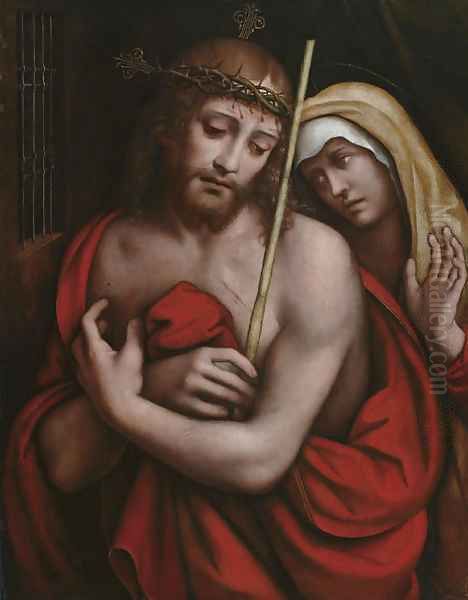
His depictions of Mary Magdalene are among his most iconic. Often shown penitent, with long flowing hair and eyes cast upwards or in contemplation, these images combine religious piety with a delicate, almost mournful beauty. The versions vary in details of costume, setting, and attributes, but consistently showcase his skill in rendering textures and conveying subtle emotional states. Similarly, his paintings of St. Catherine of Alexandria, often shown with the broken wheel of her martyrdom, are rendered with elegance and a quiet strength.
The theme of Leda and the Swan, based on a lost painting by Leonardo, was explored by Giampietrino in several versions. These works, depicting Leda embracing the swan (Zeus in disguise), allowed him to showcase his mastery of the female nude, rendered with a smooth, sculptural quality and a characteristic Leonardesque grace. His depictions of Cleopatra, often shown at the moment of her suicide by asp, similarly combine classical subject matter with a poignant, sensual beauty.
Giampietrino also produced numerous Madonna and Child compositions. These often feature the Virgin with a tender, slightly melancholic expression, gazing at the Christ Child, who is depicted with naturalistic infant proportions and often a playful demeanor. The interaction between mother and child is rendered with sensitivity, and the compositions frequently incorporate Leonardo's pyramidal structure and sfumato technique. An example is the Madonna and Child with St. John the Baptist (c. 1515), which showcases his ability to create intimate and emotionally resonant devotional images. The Madonna di Castel Vitoni is another notable example reflecting Leonardo's influence.
His Salvator Mundi (Savior of the World) paintings, depicting Christ half-length, making a gesture of blessing and holding a crystal orb, are also significant. This theme gained immense prominence with the rediscovery and attribution of Leonardo's own Salvator Mundi. Giampietrino's versions, while clearly inspired by a Leonardesque prototype, exhibit his own stylistic traits in the softness of the features and the gentle rendering of light.
Altarpieces also formed part of his output, such as the Madonna and Child with Saints for the church of San Marino in Pavia. These larger-scale works demonstrate his ability to handle more complex multi-figure compositions, though he is perhaps best known for his more intimate, half-length figures. A work like Christ Crowned with Thorns showcases his capacity for depicting pathos and suffering with a refined, almost idealized aesthetic.
The Leonardeschi: Context and Comparisons
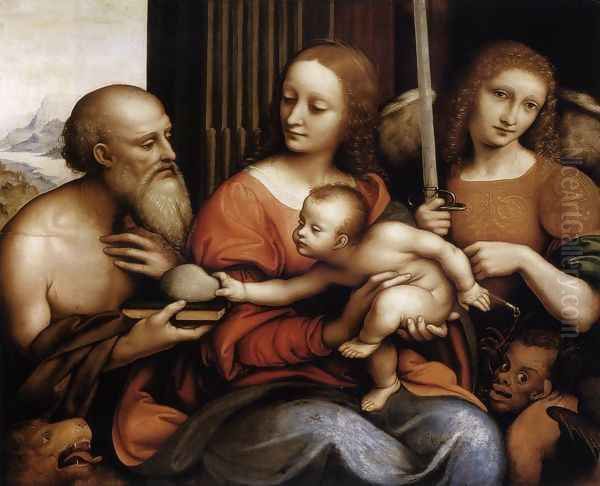
Understanding Giampietrino's contribution requires placing him within the broader context of the Leonardeschi. While all were indebted to Leonardo, each developed a distinct artistic personality. Giovanni Antonio Boltraffio, for instance, was known for his aristocratic portraits and a refined, somewhat melancholic style. Andrea Salai, Leonardo's longtime companion, produced works that closely emulated his master's style, though perhaps with less originality. Francesco Melzi, Leonardo's principal heir, was a meticulous painter whose works are characterized by their delicate execution and faithful adherence to Leonardo's late manner.
Bernardino Luini became immensely popular for his gentle, sweet depictions of Madonnas and saints, which, while Leonardesque in their sfumato and facial types, possessed a more accessible and overtly devotional appeal. Marco d'Oggiono was another prolific follower, known for his numerous copies of Leonardo's Last Supper and other compositions, often with a harder, more linear quality than Giampietrino's work. Cesare da Sesto, who also traveled to Rome and absorbed influences from Raphael, developed a more eclectic style, blending Leonardesque elements with classical and High Renaissance principles. Andrea Solario, while influenced by Leonardo, also looked to Venetian and Netherlandish art, resulting in a polished, detailed style. Giovanni Agostino da Lodi was another contemporary active in Milan, whose style shows some Leonardesque traits.
Compared to these artists, Giampietrino stands out for his prolific output, his consistent quality, and his particular skill in capturing the subtle psychological nuances and the soft, smoky modeling of Leonardo's style. He was less an innovator than a gifted interpreter and adapter, but his ability to create appealing and technically accomplished works ensured his success. His paintings often possess a dreamlike, almost languid quality that distinguishes them from the sometimes more robust or overtly sentimental works of his contemporaries.
Workshop Practices and Prolific Output
The sheer number of paintings attributed to Giampietrino, many of which exist in several versions or variants, strongly suggests that he maintained an active and efficient workshop. This practice was common during the Renaissance, allowing artists to meet the high demand for popular subjects and to train assistants. The production of multiple versions of successful compositions, such as his Mary Magdalene or Leda and the Swan, indicates a keen understanding of the art market.
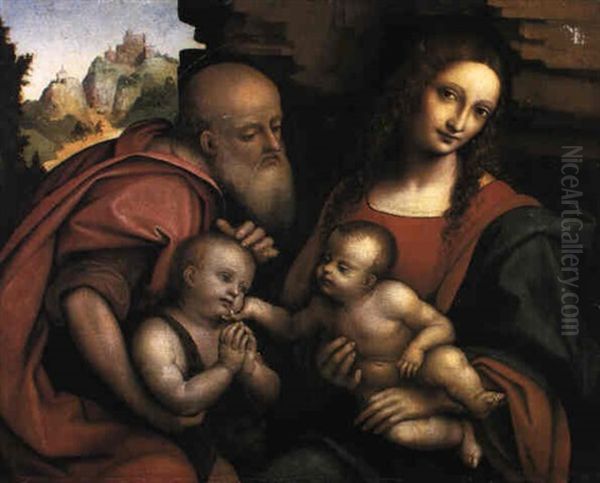
These workshop versions, while sometimes varying in quality depending on the degree of the master's intervention, generally maintained a high standard of execution. Giampietrino likely provided cartoons or detailed preparatory drawings that assistants could use to replicate compositions, with the master often adding the finishing touches to key areas like faces and hands. This system allowed for a prolific output that catered to a wide range of patrons, from religious institutions to private collectors seeking devotional images or mythological scenes for their homes. His success in Lombardy, particularly in the first half of the 16th century, was considerable, and his works were evidently highly sought after.
Later Career and Legacy
Giampietrino remained active until at least 1549. While Milan was the primary center of his activity, there is some evidence to suggest he may have moved to or worked in Savona, in Liguria, later in his career, possibly after 1537. His style, once established, remained relatively consistent, though some scholars detect a slight evolution towards a more polished, almost enamel-like finish in his later works.
His enduring legacy lies in his role as one of the most effective disseminators of Leonardo da Vinci's artistic innovations. Through his numerous paintings, Giampietrino helped to popularize the Leonardesque aesthetic, making it accessible to a wider audience and ensuring its continued influence on Lombard art for decades. His works, characterized by their technical refinement, subtle emotional depth, and often enigmatic beauty, found their way into collections across Europe.
Today, Giampietrino's paintings are held in major museums and private collections worldwide, including the Pinacoteca di Brera in Milan, the Louvre in Paris, the National Gallery in London, the Hermitage Museum in St. Petersburg, and numerous institutions in the United States. His art continues to be appreciated for its elegance, its skillful execution, and its intimate connection to the world of Leonardo da Vinci. While he may have worked in the "shadow" of a giant, Giampietrino absorbed Leonardo's "light" and reflected it with his own distinctive brilliance, securing his place as a notable master of the Lombard Renaissance.
Conclusion
Giovanni Pietro Rizzoli, or Giampietrino, remains a fascinating figure whose art provides a crucial link to the direct impact of Leonardo da Vinci on his contemporaries. As a leading member of the Leonardeschi, he not only absorbed the technical and stylistic innovations of his master but also developed a personal idiom characterized by refined beauty, subtle psychological expression, and a prolific output of high-quality works. His depictions of Madonnas, female saints, and mythological figures, rendered with a signature sfumato and delicate modeling, captivated patrons in his own time and continue to engage viewers today.
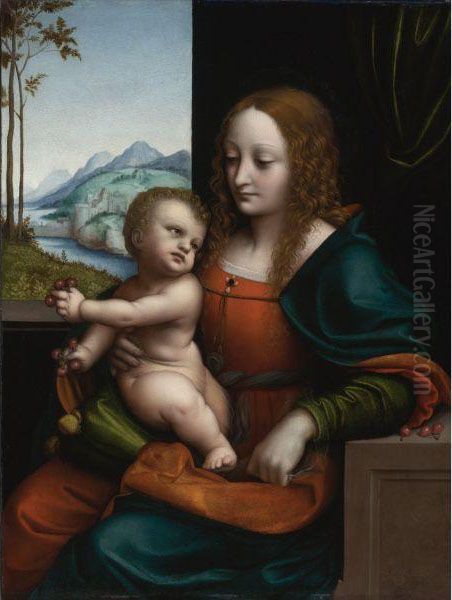
While the details of his life may be sparse, his artistic legacy is substantial. Giampietrino's ability to translate Leonardo's complex genius into a more accessible, yet still sophisticated, visual language ensured the widespread dissemination of Leonardesque principles. He was more than a mere copyist; he was a skilled interpreter who infused his works with a distinct, often melancholic and dreamlike, charm. In the rich tapestry of the Italian Renaissance, Giampietrino stands as a testament to the profound and lasting influence of a great master, and as an accomplished artist in his own right, whose contributions significantly shaped the course of Lombard painting in the 16th century.